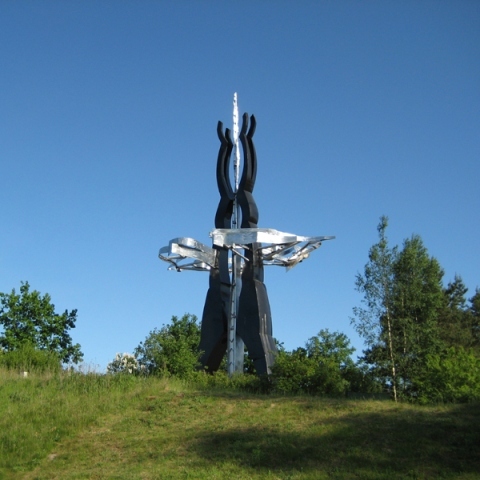Composers / Arne Nordheim / Places catalog
Storedal Cultural Centre
Storedal Cultural Centre is a park and culture reception area located in Skjeberg, near Sarpsborg. It was created by artists, natural scientists and landscape architects in such a way that visitors could experience nature and art in the same place. It is open to everyone, but particularly geared towards the blind and visually impaired.
The Centre was founded by the accordion virtuoso Erling Stordahl, and it was opened in 1970. Stordahl lost his eyesight when he was thirteen, but for the rest of his life he proved that blindness does not need to be an obstacle in anything. At the beginning of the 1960s, he devoted himself to the inclusion of the blind in sports.
When Stordahl inherited his family farm in Storedal from his father, he decided to build a cultural centre there to commemorate King Magnus the Blind, who, as Snorre claims in his sagas, was born exactly there, in Storedal, in 1117. Stordahl persuaded scientists and artists to create a Garden of Senses, with 200 different plants, a park of cave paintings and an amphitheatre integrated in the landscape. The focal point, however, is a sound sculpture 19.5 metres high, Ode til Lyset (Ode to Light), created by Arnold Haukeland and Arne Nordheim.
In 1965, Stordahl commissioned a monument to Magnus the Blind from the sculptor Arnold Haukeland. The sculpture features two tall black symmetrical buttresses, resembling arms raised in a gesture of despair to the sky. Between them, a silver spear arises, like a light which vanquishes powerlessness. In order for the blind to be able to appreciate the monument, Stordahl contacted Arne Nordheim and asked him to create its image in sound. The idea was that the blind could perceive the shape and form of the sculpture through sound. For the next four years Nordheim worked with the engineers of the Acoustic Laboratory of Trondheim University of Technology to bring Haukeland’s idea to life. The composer travelled extensively around European electroacoustic studios to discuss and work on the sound programme.
The sculpture is equipped with sensors which capture information about the light and meteorological conditions. That information affects Nordheim’s electroacoustic music, which is played on two tapes of different length. This means that the sound image presented at the launch of both tapes simultaneously will not be repeated for a long time, when the tapes meet again at the starting point. Here Nordheim used for the first time the composition technique of 'infinity', which he later developed and used in Poly-Poly (1970), his music for the Norwegian pavilion at the World Expo in Osaka.
The sounds played from the tapes are amplified by twenty-four speakers mounted on a stainless steel ring, floating in the air around the sculpture about half-way up it.
The music is now controlled via computer, operated by Sigurd Saue of Trondheim.
-

Arne Nordheim at a junction box. Storedal Cultural Centre 1967. Phot. Jan Erik Olsen/Scanpix/FORUM.
-

Sculpture <
>, created by Arnold Haukeland and Arne Nordheim in Storedal Cultural Centre in Skjeberg. (creative commons)